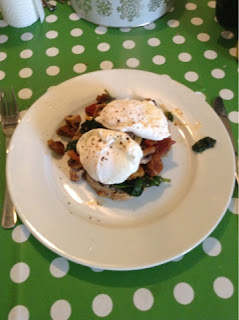I have a recipe I'm working on, and a bit of a tirade on how a perfect dough feels clammy, but I need to test the recipe a bit further before letting it loose on the internet. In the meantime I thought I'd share a seasonal recipe instead. We are really coming into apple season in the UK and I, for one, intend to make the most of this. I baked this subtly apple-flavoured loaf last week and my (as of two days ago) former colleagues were asking for the recipe.
This post is dedicated to the bunch of people I have worked with for the last five years. Thank you for the laughs and tears, for your support and for your cheese scones. You rock.
 |
| Apple loaf. Photo: Helene Frössling |
A sweet apple loaf
100 g butter (at room temperature)
200 g granulated or caster sugar
2 medium eggs
175 g plain flour
1.5 tsp baking powder
1 tsp ground cinnamon, plus a bit more for dusting
1/2 tsp vanilla essence
100 ml apple juice (not from concentrate)
1 large organic apple
"Pearl sugar"
Turn the oven to 170 degrees. Line a loaf tin with baking paper.
In a large bowl and using a hand-held electric whisk, cream the butter for a minute or so, then add the sugar and continue creaming for a couple of minutes until fluffy. In a smaller bowl mix the flour and baking powder with the cinnamon. Into the butter and sugar mix, add the eggs one at a time, incorporating the first one fully before adding the next one. If the mixture separates, add a spoonful of the flour after each egg. Swap from the electric whisk to a spatula. Mix the apple juice with the vanilla essence in a small bowl or measuring jug. Into the main mix add a third of the flour stirring it in fully, then half the apple juice, stirring again. Repeat the addition of flour, then the last of the apple juice, then the last of the flour. Finally, stir in the grated apple. Spoon the mix into the loaf tin, smoothing it down fully, and then across the top dust some cinnamon and, if you have any pearl sugar sprinkle some of that over the cinnamon. If you don't have pearl sugar, perhaps try demerara sugar?
Bake on the middle shelf for 35-40 min or until an inserted skewer comes out clean. Leave to cool somewhat in the tin before taking it out and letting it cool fully on a plate. It'll have a lovely toffee-ish smell.





